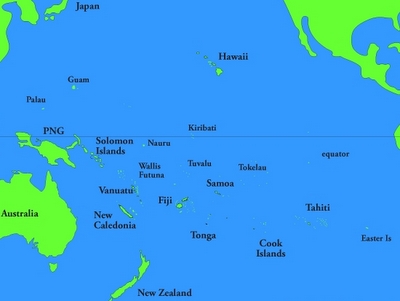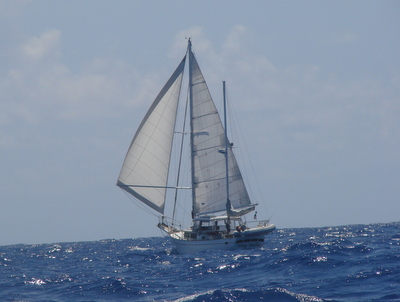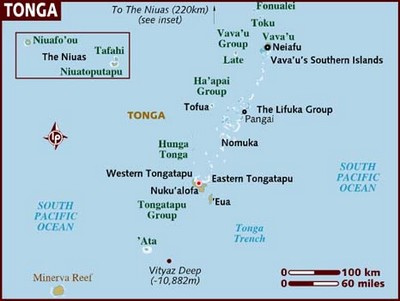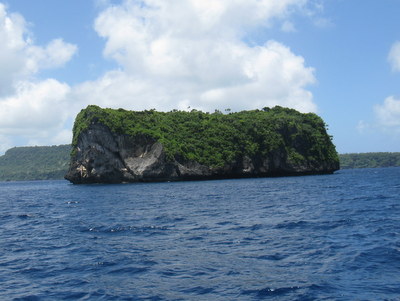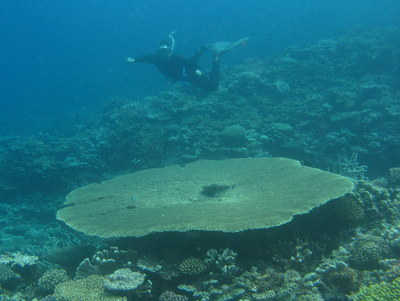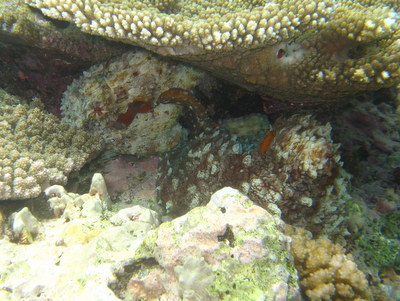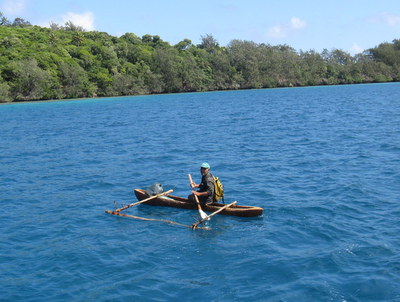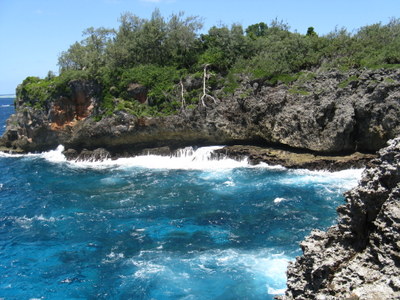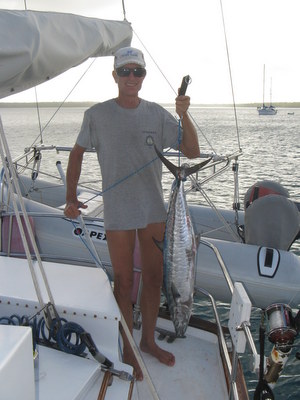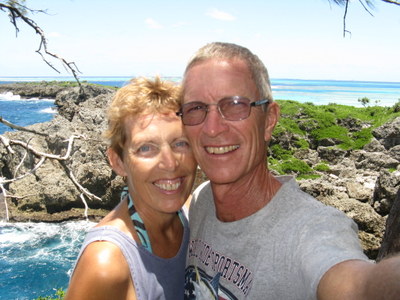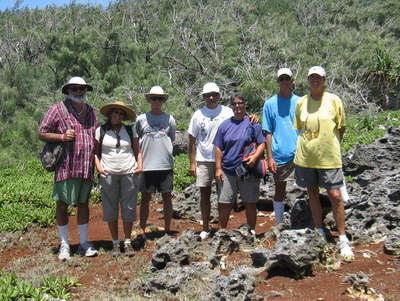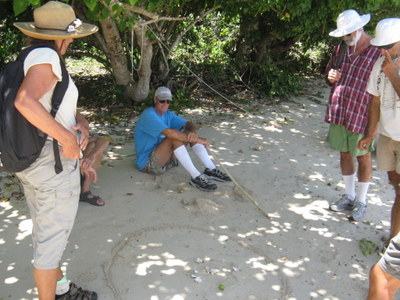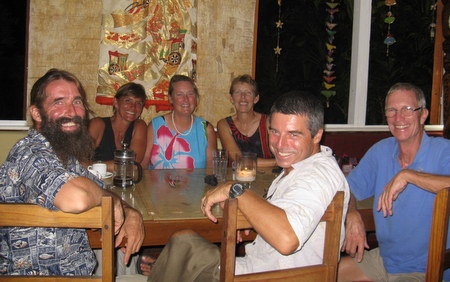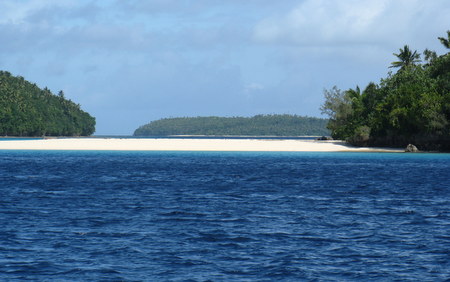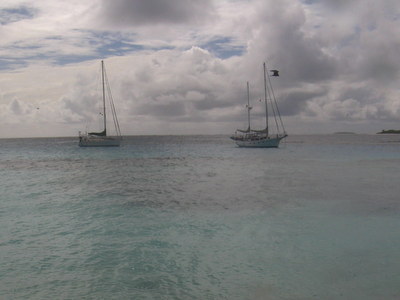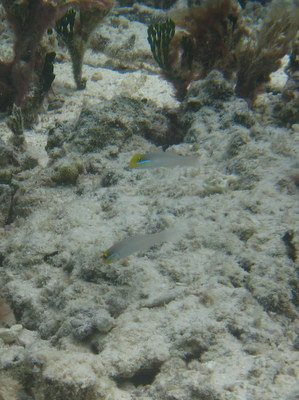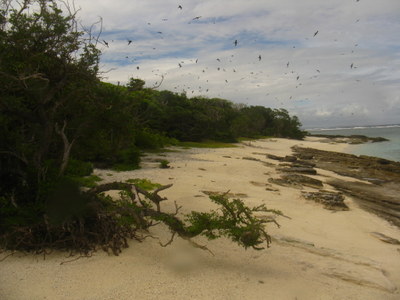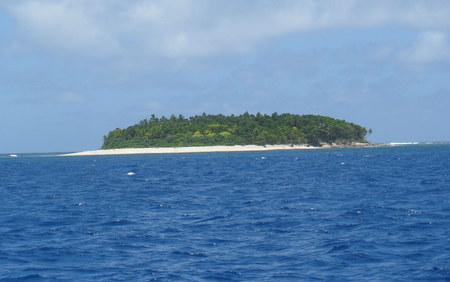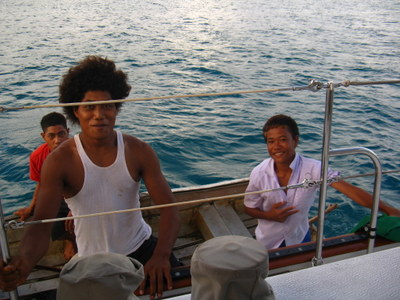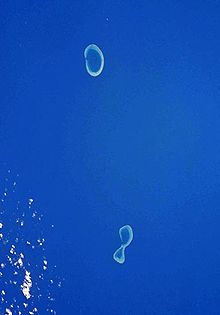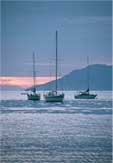
Logbook: Tonga & Minerva Reef - October to December 2011
When we departed Niue in early October, we were going into the home stretch of our 2011 sailing season. We had visited French Polynesia (Tahiti), Suwarrow Atoll in the Cook Islands, American Samoa and Niue, and now we were headed to Tonga. Our plan was to spend the next couple of months in Tonga, before continuing on to New Zealand for the South Pacific hurricane season, which would officially begin on the first of December.
|
|
|
| Passage from Niue to Neiafu, Tonga
(October 2 - 5, 250 nm, 2 days & 3 hours). With the wind at our
back, we pointed Slip Away toward Neiafu, in the Vava'u Group of Tongan Islands.
We sailed wing-and-wing on a course which took us slightly north of west, and it
was an easy trip with mostly 10-15 knots of wind and occasionally lumpy seas but no
squalls. During this passage, we sailed over the International Date Line,
so though our elapsed passage time was 51 hours, we lost a day along the way.
We approached the island group in the morning, motored into the harbor and tied
up to the Customs dock around 11 a.m.
We spent a couple of hours getting through officialdom - Customs, Immigration and Quarantine, with a lunch break somewhere in the middle. As we walked through town on our way to the Immigration Office, we saw not only stray dogs wandering the streets but also pigs running around in the yard of the Tourist Information Office - interesting! We finally pulled away from the Customs dock at around 2 p.m., but the Health Inspector was not available, so we needed to come back the next day to complete our check-in. When we returned to meet the Health Inspector at the Quarantine Office, Rich sat our backpack down on a pallet of merchandise, and as he did so, Jan saw a huge cockroach crawl on to it. Yikes! Several seconds of shrieking, swatting and stomping ensued before the trespasser met his maker. The Kingdom of Tonga. Tonga is the last remaining monarchy in Polynesia. They have been a British protectorate since 1900 but claim to be the only Pacific nation never to have been controlled by foreign powers. Tonga has over 170 islands scattered over 700,000 sq km (435,000 sq miles) of ocean; most are raised coral limestone, and a few are volcanic islands. Tonga is divided into four main island groups (from north to south): the Niuas, the Vava'u Group, the Ha'apai Group and Tongatapu, where the capital city of Nuku'alofa is located. Tonga's population is of Polynesian descent, with a total of just over 100,000, most of whom live on Tongatapu, which is home to the royal family and the central government. |
|
Vava'u Group (October 5 to November 1). Tonga's Vava'u group is comprised of 34 islands, 21 of which are inhabited, with a total population of approximately 19,000. The town of Neiafu is the capital of this group, on the largest island called Vava'u (115 sq km or 71 sq miles). Neiafu is located along the shoreline of a very well-protected and deepwater harbor called Port of Refuge. The Vava'u Group is an outstanding area for cruising because there are numerous scenic anchorages. It's only a few miles from one anchorage to the next, and several of them offer good protection from strong wind or sea conditions.
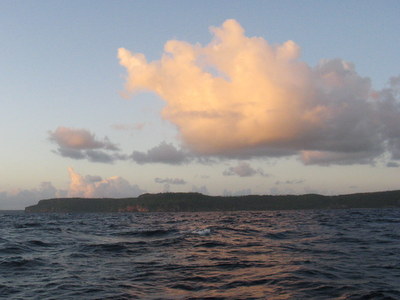 Morning arrival at Vava'u Tonga |
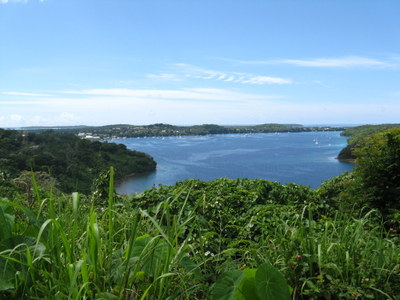 The well-sheltered harbor at Neiafu |
Neiafu (October 5 to 8). Upon arrival we spent just a few days anchored off the town of Neiafu, getting our bearings and shopping for some fresh fruits and veggies at their produce market. Neiafu isn't a big city, but it was busy place. There is some tourism here, including a Moorings Sailing Charter base, and quite a few other yachts (large and small) in the bay, so there are a number of restaurants and bars, t-shirt shops and other businesses to support the industry. A number of sailors and other travelers have made Tonga their home, and there's a strong ex-pat community. We found it interesting that most of the small businesses were owned by ex-pats - the grocery stores were mostly run by Chinese, and the restaurants, lodging and souvenir shops were mostly run by other ex-pats (Kiwis, Aussies, Americans, Canadians and Europeans). We weren't sure if the Tongan's didn't have the money or the motivation (or maybe neither) to be in charge of these businesses.
During our visit, Neiafu was abuzz with the World Cup Rugby competition, which was being held in New Zealand, and many of the games were televised in the bars and restaurants in town. The Tongan team had recently been eliminated from the tournament, but they had played well, and the New Zealand and Australian teams were advancing toward the playoffs.
Although we enjoyed Neiafu's flat calm anchorage, we were eager to get away from the town and go see what the other bays had to offer. Specifically, we'd heard there were some wonderful snorkeling spots, and once again, we were hoping to find some humpback whales, which come to Tonga during the winter months (June to November) to give birth to their calves and breed before returning to the Antarctic regions during the Southern Hemisphere summer (December to May). We saw a few whale spouts in the distance when we came into Neiafu, and we were eager to have a closer encounter with them and/or hear their songs while we were in the water.
A nice advantage of cruising in the Vava'u Group was that VHF radio repeaters were installed in numerous locations, so one could always reach boats in other anchorages, even if the distance was further than normal VHF range, or if there was a hill in between. Each morning, there was a morning VHF radio net broadcast from Neiafu, and it could be heard throughout the island group. Most radio nets are used for communication between cruisers such as weather updates, announcements of special events, etc., but this Net had a new feature we hadn't previously run across - commercials! At the end of the Net, the Net Controller would invite the local proprietors to give a spiel about services offered or restaurant menus. The commercial was supposed to be short, so the proprietor would talk as fast as possible, while trying to convey as much information as possible. The same commercials were repeated day after day. Suffice it to say, we prefer a Net with no commercials!
A peculiarity about cruising in this area is that anchorages are often referred to by number. The Moorings Sailing Charter Company published it's own cruising guide to this area, and in it, they numbered all the anchorages. We assume this came about because some of the anchorage names were difficult to pronounce. Therefore, when most folks gave their location on the radio, they would usually give the number instead of the name. We tended to rely a bit more on Ken's Guide, which called the anchorages by name, so we were often clueless when someone would say they were "Number 7" instead of "Port Maurelle."
| Ovalau Island (Anchorage #40 - October 8). When we left Neiafu, we headed to Ovalau Island, which was just 9½ miles away. Our guidebook said that Ovalau had some great snorkeling around the island, and whales often swim through a nearby channel. The downside to this anchorage is that it doesn't offer much protection - there's a small island to the east and some shelter from a reef on the south side, but other than that it's fairly open to weather. The forecast called for settled conditions for at least the next couple of days, so it seemed a good opportunity to check it out. When we arrived, there were a couple other boats in the anchorage and another arrived shortly after us. We dropped the hook, ate some lunch, donned our snorkel gear and jumped in the water. There were some dark clouds in the southern sky, and it started raining shortly after we got in the water, but we figured it was probably just a passing squall, and we swam off toward the island, which was about 1/4 mile away. While we were snorkeling along the edge of the island, the rain stopped, and a breeze picked up from the south. The wind quickly built, and we were looking at swimming back to Slip Away in about 20 knots of wind and rough, white-capped seas. Yikes! We should have brought the dinghy! We had wetsuits on which provide flotation, but we were also both wearing weight belts. It was a challenging swim back, but we made it, and we chastised ourselves to leaving the boat when what we saw on the horizon obviously did not match the forecast. Once we were back on the boat, the winds continued to blow, and when one of the other boats weighed anchor and left, we weren't far behind them. The other two boats followed us out - all of us looking for a more sheltered anchorage! |
|
Port Maurelle (Anchorage #7 - October 8 to 13). Before leaving Ovalau, we looked at our charts and guidebooks and decided to head to Port Maurelle. It was close by (just under 5 miles away) and looked like it would offer protection from weather coming out of most directions. An hour after departing Ovalau, we were anchored in a quiet and calm bay. Very nice!
We spent the next few days anchored in Port Maurelle, which was a lovely spot. We also made some new friends - Phil & Helen on Dolce Vita whom we met here and Robbie & Neville on Catwagon whom we met briefly in Niue. The six of us shared a couple of meals and some good times. Phil & Helen are New Zealanders and had spent the past couple of months cruising in Tonga, so they showed us some of their favorite snorkeling spots. Phil had become an avid fisherman since arriving in Tonga, and he headed out in his dinghy most afternoons to catch dinner. We were more than happy to take some fish off his hands when he caught too much!
The snorkeling in Port Maurelle was very good - we especially enjoyed the south shore of the anchorage, as well as along the shore of Ava Island, which was close by. The water was clear and warm, and we saw a couple of fishes we'd never seen before, as well as a few varieties of nudibranchs (sea slugs). When Bill & Cathy from Terrwyn (another couple we met in Niue) arrived in the anchorage, the four of us did a dinghy excursion out to Swallows Cave. We snorkeled in the cave and also found a great reef close by. Nice!
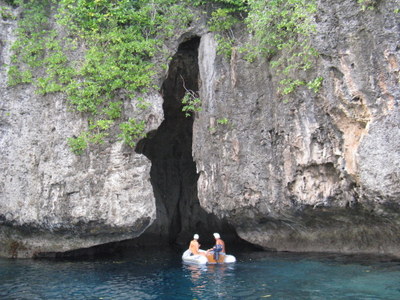 Bill & Cathy from Terrwyn exploring Swallow's Cave |
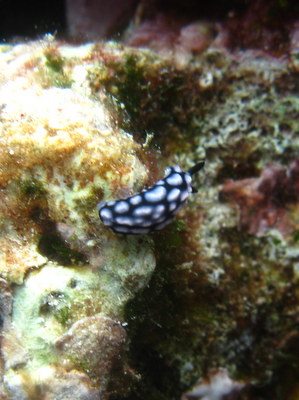 Nudibranch on the reef at Port Maurelle - he's about one inch long |
 Schooling silversides inside Swallow's Cave |
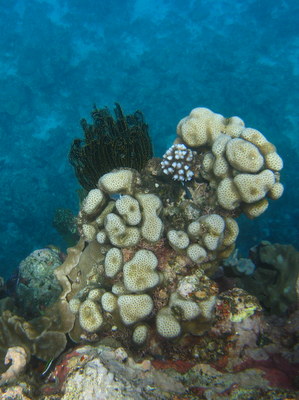 Featherstar and hard corals |
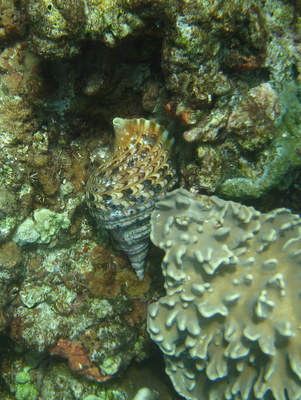 Triton's trumpet shell |
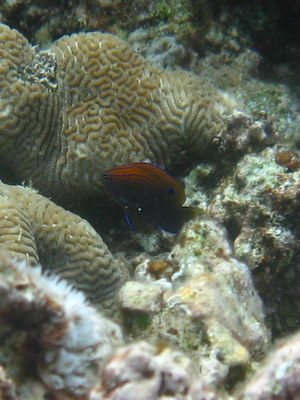 Tiny speckled damselfish |
Vaka'eitu (Anchorage #16 - October 13 to 16). After Port Maurelle, we moved 5½ miles away to Vaka'eitu, so that we could snorkel the Coral Gardens and Coral Wonder, which were two spots highly recommended by Dolce Vita. Although we didn't plan it ahead of time, Dolce Vita and Catwagon headed to that same anchorage at the same time as we did, so our fun with these friends continued. The snorkeling at the Coral Gardens and Coral Wonder was our favorite in the Vava'u Group - beautiful walls of healthy corals and great marine life.
While we were here, Phil on Dolce Vita took us out for a lesson on dinghy fishing. A couple of the valuable pointers included fishing very close to reef- "if you don't catch the reef, you won't catch a fish"- and bring along your mask and snorkel so that when you do catch the reef, you can dive in and unhook your lure. During our lesson, we didn't catch anything, but Phil caught a tasty one, which they shared with us and Catwagon at a dinner on their boat.
|
|
|
|
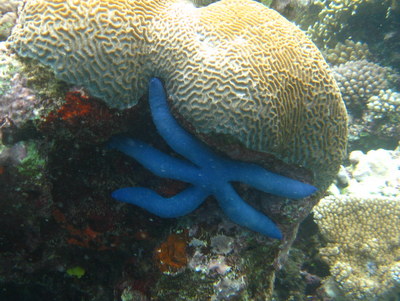 This starfish is appropriately named "Blue Sea Star" |
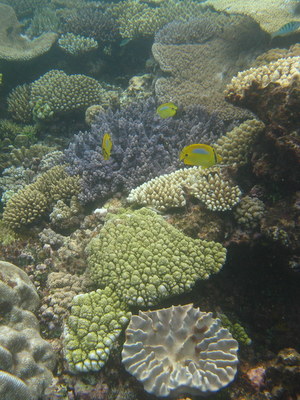 Blue-Spot Butterflyfishes swimming among the colorful corals |
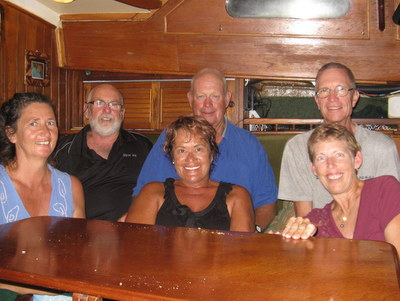 Get-together on Dolce Vita with Helen & Phil (left) and Robbie & Neville from Catwagon (center) |
One day when it was raining in Vaka'eitu, we heard Robbie on Catwagon tell Phil on Dolce Vita that she needed her "brolly." The two of us looked at each other - her what?? Robbie is also a New Zealander, so we figured this must be some local jargon. At dinner that evening on Dolce Vita, we got our first lesson in speaking "kiwi" - a "brolly" is an umbrella, sandals are called "jandals" and they use the word "wee" to describe small things like "wee bits" or "wee ones."
Our group of friends split up after a few days in this anchorage. Dolce Vita and Catwagon headed into Neiafu to watch the final game of the World Cup Rugby Competition.. The New Zealand All Blacks defeated France in that game, so there was some celebrating going on. It was an especially sweet victory for New Zealand since they were hosting the games.
Nuku/Kapa (Anchorage #8 - October 16). While many of the boats in the Vava'u Group were in town to watch the rugby finals, we found a beautiful and quiet anchorage between the islands of Nuku and Kapa (just 4 miles from our previous spot). We moved mid-day and went out that afternoon in the dinghy fishing for dinner but unfortunately were not successful in our endeavor. Rich hooked a nice fish, but it got away, and Jan only managed to catch the reef. We shared the anchorage with just one other boat, which was one of the Moorings charter sailboats. The next morning, Rich went out for another attempt at dinghy fishing, and the folks from the other boat came over to say hello. They were a nice young Aussie couple on vacation for ten days, but they had previously cruised on their own boat for a couple of years and were back at work planning and saving up for their next adventure. They were flying home later in the day and brought over to us their leftover provisions - crackers, soy sauce, salt & pepper, zip lock bags and a few other items. Very thoughtful!
After Rich returned from fishing - again no luck in catching fish, but again successful in catching the reef - we went for a snorkel. The snorkeling was good, and this was a very pretty anchorage, but after getting a call on the radio from our friends Fred & Cinda on Songline, we decided to go join them at Hunga Island.
|
Hunga Island (Anchorage #13 - October 17 to 19). We motored over to the Hunga Island anchorage (8¾ miles away), another pretty spot, and a well protected anchorage in a bay with a narrow entrance. The entrance was a little intimidating, but we had good light and followed the waypoints provided by Ken's cruising guide and had no problems getting in. That evening, the two of us joined Fred & Cinda from Songline and Randy & Jenny from Mystic for a potluck dinner on Far Fetched, with Captain Bruce and crew Billy and Kim. These folks are great fishermen and women, so there was lots of fresh seafood - yum! Jan brought a Texas Sheet Cake for dessert, which was also quite popular. The next morning, we snorkeled the outside the pass, hoping to maybe sight a passing whale (no luck there), but Jan did find a super small colorful nudibranch, which was very cool. Later in the day, we had a visit from a local guy here, named Vaha Maamaloa. He first came out to Slip Away and asked if we'd like some fruit. We said yes, and when he returned with bananas, papaya and coconuts for us, we gave him some canned goods and crackers (they call them biscuits). He then told us that he did some carvings and asked if he could bring them out and show them to us. We agreed, and the next morning, he showed up with some carvings he did from whale bones. Vaha was a very kind and soft-spoken gentleman, and we were happy to buy a small carving from him. From this anchorage, we could also dinghy over to another anchorage called the Blue Lagoon. This anchorage isn't so well protected, but the snorkeling along the outside wall on the leeward side was good, so it was nice to get there by dinghy while Slip Away remained anchored in her nice, calm spot at Hunga Island. |
|
Kenutu Island (Anchorage #30 - October 19 to 24). While at Hunga, we were keeping our eye on the weather for an opportunity to go to Kenutu Island. Hunga Island was on the western edge of the Vava'u Group, while Kenutu was on the eastern edge, about 17 miles apart. Since the prevailing winds come from the east, going from Hunga to Kenutu was an upwind trip. Since it appeared there would be no big break in the tradewinds, we finally decided to bite the bullet and motor the distance with 12-15 knots of wind on our nose. The trip actually wasn't too bad because a barrier reef along the eastern edge of this group blocked the ocean swell. While underway, we hooked (literally, on the top of his head!) a nice-sized Spanish mackerel. It was 42 inches long, and we guessed its weight to be about 20 pounds (we got 9 pounds of filets from it). We both thought this was the tastiest fish we every caught - yum!!
The weather was a bit blustery while we were at Kenutu, so it wasn't great for snorkeling, but we did do a couple of really nice hikes. The hike on Kenutu Island was especially good, and the views on the windward side were gorgeous!
|
|
|
|
|
|
|
Neiafu (October 24 to 28). From Kenutu, we headed back to Neiafu, which was 15 miles away. Kenutu is surrounded by a lot of reefs, which require good maneuverability and close attention, so we motored for an hour to get through the tricky spots. But then, we unfurled the headsail and had a lovely downwind sail for about 90 minutes before motoring the last few miles into Neiafu. We got another big hit on our fishing line, but unfortunately, this one got away!
We came back to Neiafu to pick up a few provisions and do our clearance paperwork, which was required for us to continue to the Ha'apai Group of islands, which are further south in Tonga. Neiafu had a nice produce market and a couple of good bakeries, but shopping for most other items here was an exercise in frustration. There were no large or even medium-sized grocery stores, but there were several small ones. Shopping here was also a reality check for us - we were on the other side of the world. We were now seeing canned goods which came from Asia (e.g. canned tomatoes from Thailand) instead of the Americas. We traipsed around town, going from store to store, buying what we could. Luckily, we didn't need too much, but we were pretty much out of snack foods, and the selection of those types of items was limited and often expensive. We did find some Pringles that weren't too outrageously priced, and we also bought several cans of peanuts, which were packaged in China. These were the worst peanuts we've ever tasted - they really did taste like they were made from plastic! Yuk!
| While in Neiafu, we decided to
treat ourselves to a nice restaurant meal. Phil & Helen, as well as a few
others, highly recommended the food at a restaurant called "Ovava" which is run
by an irreverent British-expat named Lawrence. Fred & Cinda from Songline
were also in Neiafu, and we asked if they'd like to join us. The morning of our
planned evening out, Randy & Jenny on Mystic called on the radio to say they
were heading into Neiafu, so we invited them too. Ovava was one of the
"nice" restaurants in town, so we all dressed up a bit. When we arrived at
the restaurant, the proprietor Lawrence greeted us. He immediately
recognized us as "the Americans" he heard on the radio that morning, talking
about his restaurant. He was happy
that we spoke so highly of Ovava and gave us all a free rum punch drink.
Nice! Dinner was outstanding here and the company of our friends was
great.
After a few days, our provisions
were purchased and our paperwork was done, but unfortunately, the weather wasn't
really cooperating. There was some bad weather forecast a couple of days
out, and we were
leery of heading to the Ha'apai before it hit because well-protected anchorages in that group
of islands are few and far between. We didn't really want to hang out in Neiafu
any longer, so we moved back out to the other anchorages. Over the next few days, we were somewhat like Goldilocks trying to find a
comfortable bed. |
|
Tapana (Anchorage #12 - October 28). First, we headed to Tapana (11½ nm from Neiafu), which is billed as a "hurricane hole", so we expected the protection to be good. There is a small business here called the Ark Gallery, and they sell artwork, and rent "hurricane moorings." Their moorings are located in the shelter of a small island, and they were all occupied, but that was OK with us because we usually prefer to anchor anyway. However, the best anchoring spot was between two small islands, so there was only a reef offering protection from the seas, and the wind funneled between the two islands. After anchoring, we did some snorkeling, which we didn't find it to be all that great, and spent a night. But we didn't particularly like it here, so we decided to look for a better spot.
| Port Maurelle (Anchorage #7
- October 29). We liked the protection as well as the snorkeling in Port
Maurelle, so we decided to head back there. It's a popular anchorage, but when
we passed it the previous day on our way to Tapana, it was almost empty. With hurricane
season approaching, many boats were already on their way to New Zealand.
By the time we got back to Port Maurelle,
however, it was no longer empty. Apparently, most of the other boats still in Tonga had the same idea as we
did. Rats! All the
best anchor spots were taken. We found a spot, but our anchor was in coral
and didn't set well. Also, we were toward the back of the pack and
didn't feel like we had good protection from the wind. The bad weather was
expected to come in the next day, so we put our heads together and came up with
yet another option. Nuku/Kapa Island (Anchorage #8 - October 30 to 31). We had previously spent just one night at the anchorage between Nuku and Kapa Islands and liked it. It had a nice sandy spot to drop the anchor, offered good protection from most directions, and it's very scenic. Nuku/Kapa was just a mile away from Port Maurelle, and it was empty. We powered over there, dropped the anchor and settled in. This felt like a good spot - and it was. The trough of bad weather passed over us that night - thunder, lightning, rain and high winds. But we were fine. The bad weather continued through the next day, so we stayed put. |
|
Maninita Island (Anchorage #31 - November 1). Now that the worst of the weather system had passed, we were eager to move on to the Ha'apai Group of Islands. A passage from Vava'u to Ha'apai is usually an overnighter, but our friends Karen & Jason on YOLO told us about an anchorage at Maninita Island in the southern part of the Vava'u Group, which would put us less than 60 miles from the Ha'apai Group. Since we were approaching summer, the days were long, and from Maninita we could get to one of the northern Ha'apai anchorages in a day trip. The anchorage at Maninita is best in fair weather, and since the weather was settling down, we decided to check it out (11 nm away). The anchorage is a small space behind an island and surrounded by reef, and we shared it with Jim & Linda on Chesapeake. It was a tight fit, but we could make it work. We snorkeled, walked on the beach and enjoyed sunset cocktails with Jim & Linda.
|
|
|
|
Passage from Maninita Island (Vava'u Group) to Ofalanga Island (Ha'apai Group) (November 2,56 nm, 10¾ hours). We were up before dawn so we could get an early start to make it to the Ha'apai Group with good light. We motored out of the anchorage shortly after 6 a.m., carefully following the track and waypoints from our arrival, but with the sun behind us and super clear water, even at that early hour we could actually see the reef. Chesapeake followed us out of the anchorage and motored behind us for about a mile until we passed between the final set of reefs. Once clear of these, we both set our sails and turned the engines off. The wind was blowing in the high teens from the ESE, and our course was SW, which put it wind about 60 degrees off our port bow. Although Slip Away was sailing just fine on this course, she was no match for Chesapeake, which is an Outbound 46, a longer, faster, sleeker boat. It seemed like in no time, Chesapeake was out of sight. Seas were a bit lumpy at first, but by early afternoon the wind eased to 12-14 knots and the seas were calmer. Chesapeake made it to our anchorage at Ofalanga Island at 2:30 p.m. Slip Away made it at 4:45 p.m. While we were under way, we crossed paths and chatted on the radio with King Bee, a sailboat from Japan. King Bee was the first Japanese cruising boat we've met, and yet another reminder that we are on the other side of the world!
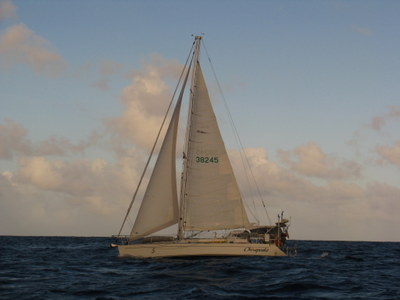 Chesapeake as she leaves us in her wake |
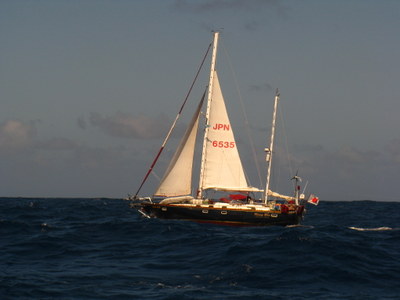 Crossing paths with King Bee from Japan |
Ha'apai Group
There are 62 islands in the Ha'apai Group, mostly low-lying islands with white sand beaches and palm trees. The Ha'apai islands are considered one of Tonga's best kept secrets - few visitors come here because there are very limited services. Only 17 of the islands are inhabited (total population of about 8,000), and only four of the islands have electricity. The Moorings Charter boats don't come down to this part of Tonga, and some cruisers skip it because most charts aren't accurate and many of the anchorages don't offer good protection. Folks we know who visited here loved the crystal clear water and pristine reefs, so we were excited to see this area, but our excitement was tempered with a bit of trepidation. However, we felt quite fortunate that friends recently shared with us some electronic charts which were developed from "Google Earth" shots and gave us a much better view of both reefs and clear areas.
Ofalanga Island (November 2). The anchorage at Ofalanga is easy to enter, and it has a great sandy bottom with plenty of space clear of any coral heads. The one negative is that it is completely open to the south and west, so it's really only usable in easterly to northerly winds, and even then, it can get rolly. When we arrived, the wind was blowing from the ESE, so it was slightly rolly, but it was a good stop for a night. Ofalanga also has some gorgeous snorkeling. When we approached the anchorage, we noticed a couple of very large coral heads off the bow of the boat, and the water here was clear and a beautiful azure blue color. Once Slip Away was settled at anchor, Jan was eager to get into the water to explore. Rich decided to relax a bit with his book, so Jan donned her gear, jumped over the side and swam forward to the coral heads. She found two very large mounds covered with healthy coral and teeming with fish. Gorgeous! After puttering around there a bit, she swam along the reef on the south side of the island, but the snorkeling here wasn't as impressive. She swam back to Slip Away super enthusiastic and eager for Rich to see these coral heads. The next morning, the crews of Slip Away and Chesapeake both swam out to see them - colorful corals, a school of squid, good-sized groupers and lots of colorful tropical fish. Very nice!
Ha'ano Island (November 3 to 6). After our morning snorkel, we headed off to Ha'ano Island, an easy trip distance-wise since it was only 10½ miles from Ofalanga. However, Ha'ano lay ESE of Ofalanga, and we had 15-18 knots of wind right on our nose. Since Slip Away doesn't sail to weather very well, we chose to just motor directly to the anchorage. Chesapeake goes to weather just fine, so they chose to sail it, heading south from Ofalanga and then tacking back to Ha'ano, which took her slightly longer than us, but they used no fuel. Karen & Jason on YOLO were already anchored in Ha'ano, having arrived there a couple of days earlier. When we spoke to them on the radio, they told us the snorkeling was excellent here, so we were eager to get in the water. We spent a couple of days snorkeling here, and it was gorgeous - clear water, beautiful corals, great fish life and lots of diversity - from a wide variety of butterflyfish to several Spanish dancer nudibranchs, a lionfish swimming out in the open water, and a clown triggerfish. Fabulous!
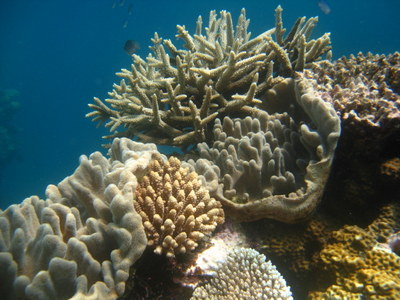 Clear water and beautiful corals at Ha'ano |
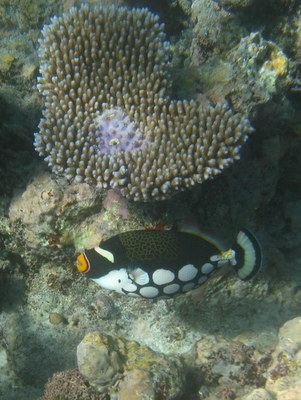 Clown triggerfish |
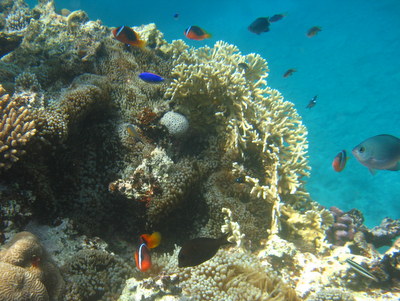 Lots of tropical fish on this reef |
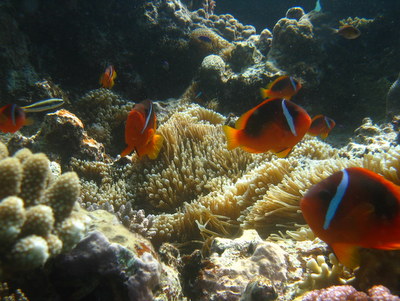 The colony of anemonefish we saw at Ha'ano was the biggest we've ever seen |
 Spanish Dancer nudibranch (about 2 inches long) |
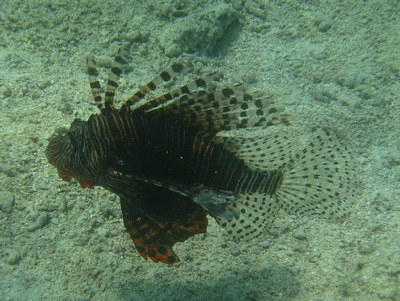 We usually see lionfish hiding in the coral, but this guy was out for a swim |
About a mile away from the anchorage at Ha'ano, on the northern end of Foa Island, there was a small resort called the Sandy Beach Resort (possibly the only resort operating in Ha'apai). Our guidebook mentioned a dive shop here, and we wanted to see if they ran dive trips to some of the offshore islands where there was supposedly excellent diving. The offshore islands were too far to go by dinghy, and they didn't have very good anchorages for Slip Away, so we were hoping we could dive some of these spots with a local shop. We were still holding out a glimmer of hope for a Humpback whale encounter, although that was starting to die out because we hadn't seen any whales in the area in weeks. We dinghied over to the Sandy Beach Resort and spoke with the owner (a German ex-pat), but no joy. They closed their dive operation a few years ago. Bummer!
One of the islands we were particularly interested in diving was Luahoko Island, which was just 6½ miles from the anchorage at Ha'ano. Our guidebook used numerous superlatives to describe the snorkeling and diving here and stated that "underwater scenery is unlikely to be surpassed anywhere in Tonga." Luahoko was calling our name.
Luahoko Island (November 5). There was an anchorage at Luahoko, not great, but usable as a day anchorage in settled weather. Since it was a short distance and the weather was fairly settled, we figured we could go out to Luahoko in the morning, spend a few hours in the water and then come back to Ha'ano for the evening. We invited YOLO and Chesapeake to come along, and the six of us headed for Luahoko on Slip Away. When we got to Luahoko, we dropped the anchor and tried to set it, but wind was blowing us one way, and the current was carrying us the other. We weren't feeling totally comfortable with the anchorage, and Jason from YOLO volunteered to stay on Slip Away while we snorkeled. In addition to Slip Away's dinghy, we had towed Chesapeake's along with us, so the five of us took the two dinghies toward the south shore of the island, where there was an opening in the reef to reach the island. We weren't really here to explore the island, so we didn't go ashore, but we were hopeful that the snorkeling in the pass and the reef surrounding the island would be good, and the currents wouldn't be so strong. Unfortunately, this was not the case - the water near shore was murky, and there wasn't much to see. So, we hung together, held on to the dinghy painters and swam to the outer reef, where the strong current carried us back to Slip Away. The water on the outer reef was clear and the corals were pretty, but we all pretty much felt the snorkeling at Ha'ano was better. Oh well, nothing ventured, nothing gained. After our morning snorkel, we had lunch and then motored back to Ha'ano. |
|
On our way back to Ha'ano, we had an equipment failure - the pump on our aft head failed and created a nasty stinky mess. Why do things like this happen when you have four other people on the boat?! When we got back to Ha'ano, the others went for an afternoon snorkel, while Rich did the head repairs and cleanup. Jan's assistance wasn't really needed for the head repair, but she stayed aboard for moral support.
We spent one more day anchored at Ha'ano and did some more snorkeling. The longer we stayed here, the more we liked it and the more interesting stuff we found underwater. Ha'ano was definitely our favorite anchorage in all of Tonga. We wanted to spend more time here, but one afternoon the wind started blowing from the south, and the anchorage became uncomfortable. It wasn't unsafe, but we were concerned that if the wind picked up, it might become so. So, we picked up our anchor and moved on.
Foa Island (November 6). An anchorage near the south end of Foa Island was just 4½ nm from Ha'ano, and the island provided good protection from the southerly winds that came up. The snorkeling here was nothing to write home about, but it was a good place to spend the night.
Lifuka Island / Village of Pangai (November 7). The capital of the Ha'apai Group is the village of Pangai on the island of Lifuka (7½ nm from the anchorage at Foa), and we needed to check in here with the Customs/Immigration officer. Our check-in/out paperwork was very quick and easy, and we found the people in town to be quite friendly. We were also able to purchase a few provisions and were pleasantly surprised to find a nice selection of fruits and veggies at their produce market. We picked up just a couple of other items in the local stores, and then the two of us also stopped for an early lunch at the Mariner's Cafe, which is run by a former cruiser and British ex-pat. While there, they asked us to sign their guestbook, and we perused the names of folks who visited before us, finding several we knew. We got back to Slip Away about noon, weighed anchor and moved a bit further south to Uoleva Island, which was just an hour away (5 nm).
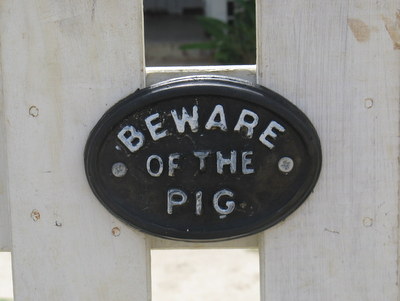 Sign on the gate of a business in Pangai |
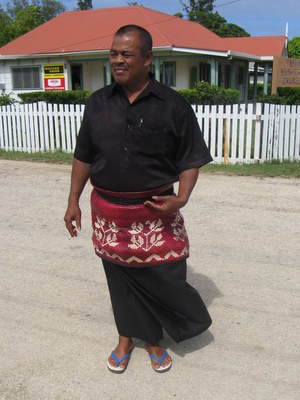 The Customs/Immigration officer in Pangai. We saw men in American Samoa wearing skirts (lava lavas), but the mat wrapped around the waist (ta'ovala) was something new in Tonga. |
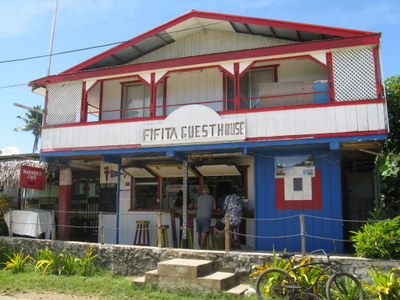 We enjoyed a nice meal at the Mariner's Cafe on the bottom level of the Fifita Guesthouse. |
Uoleva Island (November 8 to 11). We were continuing to share anchorages with YOLO and Chesapeake, and we spent the next few days snorkeling, beach combing and sharing drinks and meals with these friends. Karen on YOLO and Linda on Chesapeake are both enthusiastic shell seekers, and although Jan will sometimes pick up a shell or two when walking the beach, she doesn't spend a lot of time actively looking for them. However, during her forays ashore with the other two ladies, she started to put together a small but nice collection. The snorkeling here was good, but again not as nice as Ha'ano. From Uoleva, we split off from the group for a few days. YOLO and Chesapeake were headed to an island which promised excellent shelling, but we were hoping to find more good underwater scenery.
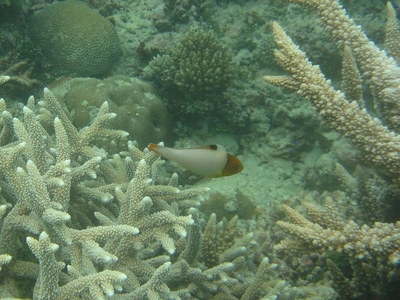 Juvenile bi-color parrotfish |
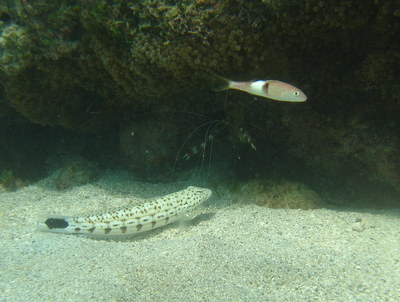 Speckled sandperch, banded coral shrimp and an unidentified little fish at the top, which is probably some kind of wrasse |
Ha'afeva Island (November 11). Ha'afeva Island is located 19 nm from Uoleva, and the course is just slightly south of west. With 15 knots of wind coming from slightly south of east, it was a lovely downwind sail. It became even more lovely when we landed a 45-inch mahi mahi. Outstanding! We arrived at Ha'afeva late afternoon, had fresh fish for dinner and spent a peaceful night. The next morning, we decided to go for a shore excursion. There is a small village ashore, and we'd heard from friends that there was a guy named Pita who would trade for fresh fruit. Although we had gotten some fresh fruits in Pangai, we would be happy to get some more. As we walked along the path heading to the village, Pita found us and offered to get us some fruit - a mango, some bananas and a couple of coconuts. We met some of his family members and gave them some pens, notebooks, nail polish and lipstick. Pita seemed a bit odd to us, but we didn't think too much of it. As he walked with us toward the village, Pita asked if he could come out to see our boat. We felt a little uncomfortable with this because although we are not affluent by American standards, we are outrageously rich compared to most Tongans. But since Pita had welcomed us into his home (truly just a shack), we felt we should welcome him into ours. We told Pita we wanted to spend some time visiting the village, so he said he would find us on our way back to the boat. The more time we spent with Pita, the weirder he got, and we were hoping we would lose him, but the island isn't all that big, so no such luck! On our way back to the boat, he wanted to stop and have us take photos with him by an old building. When we did this, he put his arm around our shoulders like we were best buds. This is extremely unusual behavior in a Tongan - all of our guidebooks told us that public displays of affection, even married couples holding hands, were very frowned upon in Tonga, and here is this guy we just met with his arms around our shoulders! When we got to the dinghy, he hopped in and asked Rich if he could drive it to Slip Away. Rich politely declined. Once at Slip Away, our plan was to give him a quick tour and take him back ashore, but then he parked himself on our settee and wanted to chat. It got worse when he asked Jan if she could give him some tea and cake. Our patience was running out. Then Pita started commenting on all of our stuff, and we felt like he was "casing the joint." When he said how lucky we were to have two handheld VHF radios, and how he could really use one, that was the straw that broke the camel's back, and Rich immediately told him he was taking him back to shore. As Pita was reluctantly climbing into the dinghy, he continued to ask for things - do you have any rope, extra shoes, beer, coke, an extra anchor, and on and on. We gave him some line for the fruit he gave us, but we couldn't wait to get this guy off our boat!
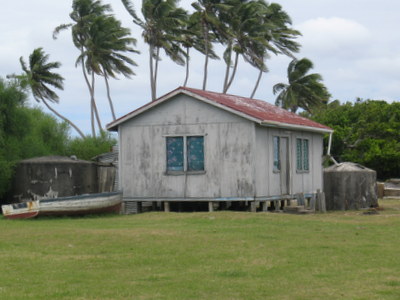 A typical Tongan home on Ha'afeva... |
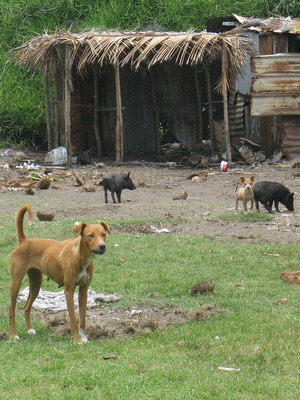 ... with dogs and pigs in the side yard |
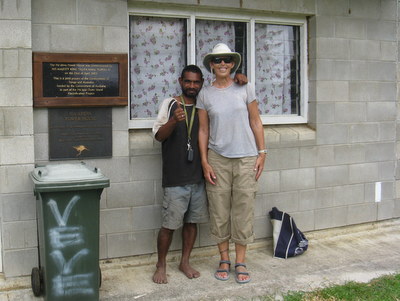 Pita with Jan, who looks like she's smiling, but she's really cringing. |
We had planned to spend the afternoon snorkeling, but after our experience with Pita, we didn't feel comfortable leaving the boat unattended. We even felt a little uncomfortable about spending another night in this anchorage. But, where could we go? By this time, it was mid-afternoon, so our hours of good sunlight were dwindling, and we couldn't go far. We had already come across a couple of uncharted reefs, so we wanted the sun to be high in the sky or behind us so we could see any obstacles. We had talked with Karen & Jason on YOLO earlier in the day, and they were 10 miles away at Oua Island, and within VHF range. We called and got them on the radio. The anchorage at Oua is surrounded by reef, but Oua has a village ashore, and remarkably, the entrance is a marked channel. We figured we had just enough sunlight to get there safely. We weighed anchor and motored to Oua with 18-20 knots of wind on our nose - not a fun trip, but we were glad to be far away from Pita.
| Oua Island (November 12 to
17). Oua was our intended destination after Ha'afeva anyway - we just got
there a day sooner than planned. Oua didn't particularly appeal to us as a
destination, but we came here to seek shelter from some approaching bad weather. There was a
low pressure system headed our way, and this anchorage offered about
the best protection we would find in the Ha'apai Group. The forecast was
calling for strong winds from the north (up to 40 knots), and the island would
provide protection from that direction. Additionally, the anchorage is completely surrounded by
reef. Although the reef wouldn't offer any protection from the wind, it would
cut down the
seas. YOLO was already here. Chesapeake had continued further south
to the harbor at the capital city of Nuku'alofa on the island of Tongatapu.
The water was murky in the anchorage, making for lousy snorkeling, so we focused on a few boat chores. We don't necessarily like to spend the entire day working (we are "retired" after all!), so we usually did a few chores in the morning, and goofed off in the afternoon. After her chores were completed one morning, Jan called Karen on the radio and asked if she would like to play a game of Scrabble. Karen was thrilled that Jan had a Scrabble board, and since neither Rich nor Jason liked to play, the boys were both very pleased that they did not have to participate. Although Jan was used to playing "fun" games of Scrabble, Karen was accustomed to playing very competitive ones with her family. Jan had a thing or two to learn about this game! The ladies ended up playing numerous games of Scrabble as we traveled together through Tonga, and although Karen usually won, the longer they played, the closer the scores got, and Jan even managed to win a couple. |
|
Between boat chores and Scrabble games, we watched the weather. The low pressure system developed into the first "tropical depression" of the season, something we weren't terribly thrilled about. The system was moving slowly toward us, and it kept slowing down. It was supposed to arrive on Monday evening, then Tuesday, and it finally arrived on Wednesday. The strong north winds never materialized - it started with 30+ knots of wind from the east, then some very light north winds as the eye of the storm passed over us, then 30+ knots of wind from the west, along with lightning and thunder. And, of course the bad weather came at night. The reef did a reasonable job of knocking down the waves, but it was a sleepless night as the crews of Slip Away and YOLO kept careful watch. If we started to drag, we wouldn't have much time to react before we'd be on the reef. But we both did just fine (sigh of relief!). Fortunately, there were only two of us in the anchorage, so we were both able to put out extra chain, and our anchors stayed buried in the sand.
Nomuka Iki (November 17 to
19). With the tropical depression past us, it was time to continue our
exploration of the Ha'apai Group. YOLO and Slip Away left Oua and headed to Nomuka Iki, 17 miles
away. The wind was blowing in the mid-teens, about 60 degrees off our bow,
and we had a couple hours of good sailing. Nomuka Iki was a pretty little
island with a beautiful white sand beach, and we had a nice walk ashore the
afternoon of our arrival. The next day, we did some snorkeling, holding on
to our dinghies and riding some strong currents running through here.
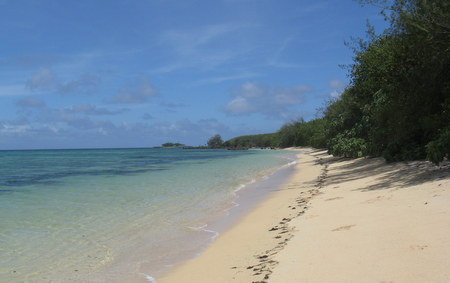 Beautiful beach at Nomuka Iki |
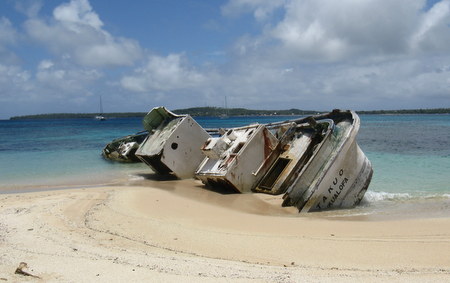 Anchoring off a beach with a wreck on it didn't necessarily give us a warm and fuzzy feeling. |
Kelefesia (November 19 to 24). Our next destination was Kelefesia, which sits south-southeast of Nomuka Iki by about 17 miles. Unfortunately, the wind was blowing from the direction we wanted to go, but we decided to go for it since it wasn't forecast to blow strong, and we felt this was our best chance to get there. We motored the distance, and the wind was light as forecast, but sometimes the seas were rough due to strong currents in this area. The fishing was reportedly good in this area, but we only managed to snag a small bonito, which we threw back. A flock of boobie birds chased and dived after our lures, so we eventually pulled the lines in.
We found the anchorage at Kelefesia to be pretty but strewn with coral heads. It was also very rolly - our flopper stopper saved the day here! YOLO stopped at another anchorage on the way to Kelefesia, so we had this one to ourselves for a couple of days. We went ashore and found a camp used by fishermen, but no one was around. We thought we wanted to hike to one of the bluffs on the island, but there wasn't much of a path, and we kept running into spider webs with huge spiders in them - yikes! We bagged the hike and decided to do some snorkeling. The snorkeling here was good - not outstanding, but we found several large, live cowrie shells - more than we'd ever seen anywhere else.
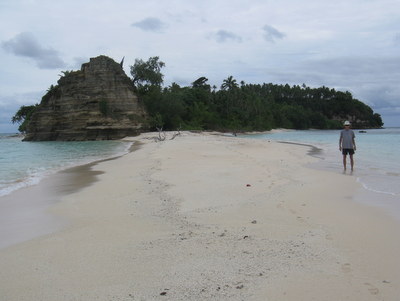 Rich on the sandbar at the north end of Kelefesia |
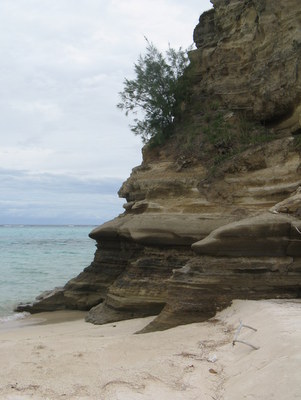 Beautiful limestone formations on this island |
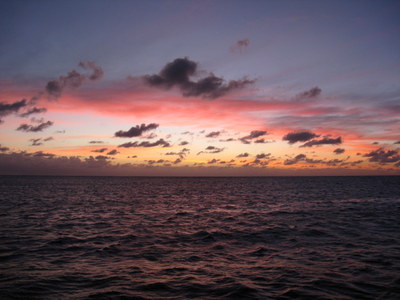 Very colorful sunset at Kelefesia |
Kelefesia was our last stop in the Ha'apai Group, and our cruise through Tonga was drawing to a close. Hurricane season was upon us, so it was time to get on our way to New Zealand. Before departing Tonga, we needed to stop in at Nuku'alofa, which is the capital city on the island of Tongatapu, to pick up a few provisions and check out with officialdom. Although we could take our boat into the harbor at Nuku'alofa, we preferred the option of anchoring at the island of Pangaimotu, which sits about a mile offshore of town. Pangaimotu sits about 50 miles south-southwest of Kelefesia, so with an early start, we could get there in a day.
Pangaimotu & Nuku'alofa (November 24 to 30). We weighed anchor at Kelefesia at 6 a.m. There are some reefs to avoid in this area, but we plotted a course through them using a combination of our inbound track, waypoints from our cruising guide and the "Google Earth" charts, and fortunately, the light was sufficient for us to see what we needed to see. Shortly after clearing the anchorage and surrounding reefs, we set our headsail and mizzen, and with 16-18 knots of wind on our beam, we were scooting along nicely at 7 knots. YOLO left about an hour after us. Since they are a catamaran, they're faster, and it didn't take them long to catch up and pass us. If we had known the passage would go so fast, we could have slept in a little longer - we were anchored at our destination by 2 p.m.
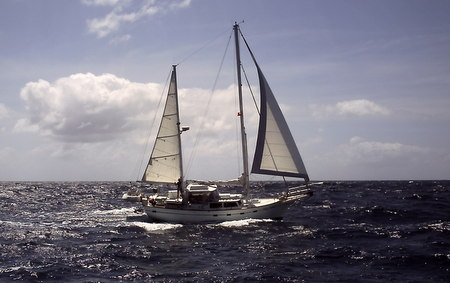 Slip Away sailing quite nicely on the way to Pangaimotu |
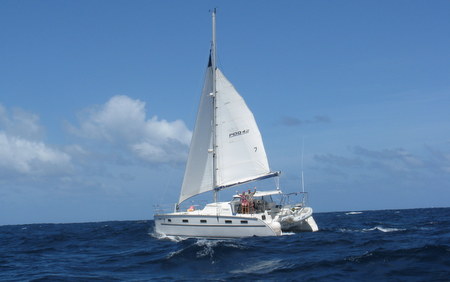 But YOLO flies by us |
We anchored at Pangaimotu just off the restaurant/bar/cruiser hangout called "Big Mama's" (owned by a Tongan!). Once we got Slip Away settled at anchor, we dinghied ashore, looking forward to a late lunch/early dinner of Big Mama's famous fish and chips. The bar was open, but we were disappointed to find the kitchen closed until early evening. Bummer! Since we were tired from our early morning departure, we didn't want to wait around until the kitchen reopened, which would have meant a late dinner. We drank a beer, talked a bit with Big Mama, and then headed back to Slip Away. We stopped at YOLO on our way home, and they were grilling fish and about to sit down for dinner. We must have looked pretty forlorn and disheartened when we told YOLO about our dashed plans for having dinner ashore, and they told us they had enough food for four and insisted that we join them for dinner. What are friends for?!
The next few days kept us busy - completing our checkout paperwork with the officials, topping off our fuel tanks, shopping for provisions and preparing for our next passage. We had 1,000 miles of ocean between Nuku'alofa and New Zealand, with no fuel stations in between, so it was imperative that we fuel up. This was somewhat of a challenge because we wanted to use jerry jugs rather than bringing Slip Away into the concrete fuel dock, which looked capable of putting huge gashes in our hull. Once again, YOLO helped us out. They had a bunch of jerry jugs filled with diesel on board, and after topping off their tanks, they still had a few full ones leftover. They offered that we could dump them into our tank, and return the jugs to them full. Between their leftovers and the two full jerry jugs we had on deck, we had just enough fuel to top off our tanks. Perfect! We loaded all the empty jerry jugs into YOLO's and our dinghies, took them to the fuel dock, filled them up and then dinghied back. Hauling a dozen or so full jerry jugs by dinghy across the mile-wide channel was a challenge, and we were quite lucky to have had a calm day to do it.
Completing our check-out paperwork required visiting several offices, including the Harbormaster (twice), Immigration and the Port Authority (which collects money for the use of their harbors). Friends who had gone before us told us of a great bakery across the street from the Immigration office - they had incredible meat pies! Finally, we picked up just a few groceries in town. The shopping in Nuku'alofa was much better than in Neiafu - expensive, but much better selection. We really liked the produce market in Nuku'alofa for fresh fruits and veggies and stocked up on those. We needed to manage our purchase of fresh items - enough to get us to New Zealand, but no more than necessary, because upon arrival, officials there would take away any fresh fruits, veggies and meats. But, with a 1,000 mile passage and a planned stop enroute at Minerva Reef, we still needed enough food to feed ourselves for a couple of weeks.
We had heard some negative reports about Nuku'alofa from other cruisers, but we quite liked this town. It's the biggest city in Tonga and the center of commerce and government. About 70,000 people live on the island of Tongatapu. For the most part, the people were friendly, and the local market where we bought fruits, veggies and a few souvenirs was great! We had lunch at a small restaurant, which was owned by a Tongan family, and we had a very pleasant conversation with the woman who was running it. Overall, we thought this was a good stop.
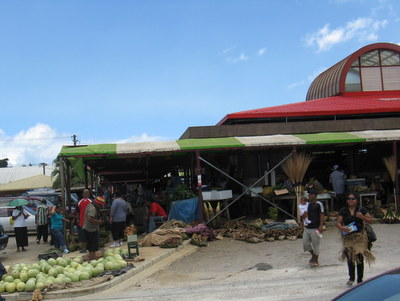 The market in Nuku'alofa where one can buy fruits, veggies, souvenirs, flowers and other assorted items |
 Rich & Lincoln at the fuel dock - Lincoln was super nice and very helpful. |
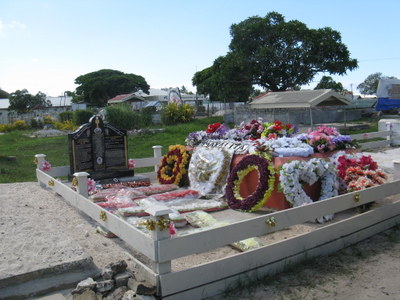 The graveyards in Tonga were very elaborate |
Passage from Pangaimotu Island to North Minerva Reef (November 30 to December 2, 270 nm, 46½ hours). We planned our departure from Pangaimotu for mid-morning in order to have good light to wind our way through the reefs around Tongatapu. Shortly after weighing anchor, we unfurled our headsail and turned off the engine, and we sailed that way for the next hour and a half - jibing three times, as we sailed through the narrow and shallow Egeria Channel. We dragged our fishing lines through the channel and hooked on to a couple of fish, but we had no idea what they were. The entry we made in our logbook described them as "long and snotty", and we threw them back. Shortly after clearing the Egeria Channel, we raised the mizzen, and we were enjoying a lovely sail with 15 knots of wind from the east and slight seas. A few hours later, the wind built a bit - into the high teens, and the seas got very lumpy - no longer a lovely sail. The rest of the trip was rough - with winds blowing 15-25 knots (one squall with 30-35 knots of wind) and seas up to about 3 meters. The winds and seas finally abated on the morning of our arrival at North Minerva Reef. It had been a rough trip, but we got there quickly, and we burned very little of our precious diesel fuel.
| Minerva Reefs
Minerva Reefs are about as remote a place as one can find. They sit 260 nautical miles from Tonga and 800 nautical miles from New Zealand - literally in the middle of nowhere. Minerva is comprised of two reefs - North and South - and they are both submerged atolls. At low tide, they barely stick out above the water, and at high tide, they are covered. Both reefs have deep passes through which yachts can enter into the inner lagoon to anchor. Anchoring here is somewhat akin to anchoring in the middle of the ocean. North Minerva Reef (December 2 to December 10). We arrived at Minerva in the morning, motored into the pass and across the lagoon, and dropped our anchor along the northeastern edge of the reef. Our friends on YOLO arrived a couple hours earlier than us and were anchored close by, and another boat Two Ticks (Adrian & Liza) from South Africa was also anchored inside. After dropping the anchor, we treated ourselves to a hearty breakfast, and then we laid down for a well deserved nap. Later that afternoon, a couple of British boats - Northern Rose (Glenn & Pat) and Baroness (Jim & Christine) arrived and joined us in the anchorage. The next day dawned bright and beautiful, and it was Jan's birthday! It was also a very windy day, and at high tide, with the water coming over the reef, the anchorage was pretty rough. So, we didn't stray far from the boat, but Jan & Karen played a few games of Scrabble in the afternoon, and Karen baked some brownies to celebrate. This was by far the most remote place Jan ever celebrated a birthday! Two more boats arrived at North Minerva that day - Madrona (Owen, Carrie, Tamsyn & Griffyn) and Fugue (Bob & Sue). Over the next couple of days, we spent some time snorkeling in the crystal clear waters, and YOLO ended up hosting two parties. YOLO was the only large catamaran in the anchorage, and when 7 boats with a total of 16 people on board showed up here, they offered to host a happy hour get-together. During that gathering, we learned that the very next day (December 5), was Tamsyn on Madrona's 9th birthday, and she really wanted a birthday party. None of the other boats in the fleet were really big enough for all 16 of us, and there's no beach at North Minerva, so Karen & Jason had everyone back to their boat again the next day. They were very gracious hosts! |
|
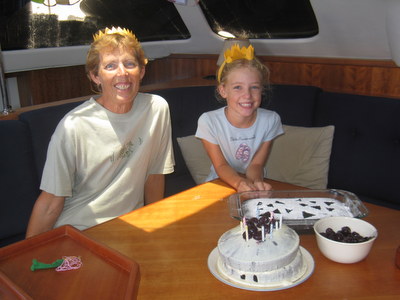 The two birthday girls - Jan (Dec. 3) and Tamsyn (Dec. 5) |
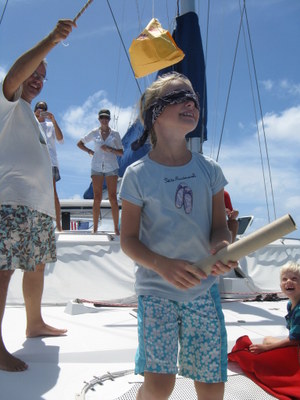 South Pacific version of a piñata game on the bow of YOLO |
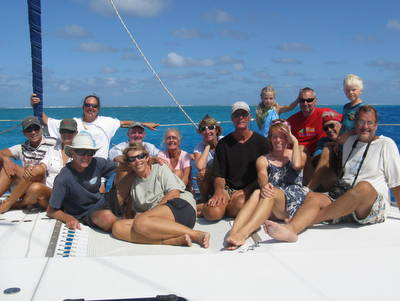 Birthday party attendees |
After the birthday party, some of the other boats started making plans to depart for New Zealand. According to the local weather guru (Bob McDavitt), there was a weather window to get there, but one could expect boisterous winds the last part of the trip. Northern Rose, Baroness and Two Ticks headed out, but we decided to wait a bit longer because the winds at Minerva were forecast to go light for a few days. The winds had been pretty strong since we had arrived, and we hadn't spent as much time in the water as we would have liked. We wanted to see more of the underwater world here.
We ended up spending four more days at Minerva with beautiful, calm conditions. Another boat showed up - Jamie, with Tamás, Sara and David on board. They were scuba divers, so we had some dive buddies. The best diving was right at the pass, and Jamie anchored just inside it. Since the winds had lightened up, we moved Slip Away over there too. The diving was spectacular - huge groupers, sharks and a beautiful variety of tropical fishes, most of which were larger than what we were used to seeing. The crew from Jamie did one dive at the pass before we got there, and they saw a hammerhead shark. We never got to see it, but we didn't really mind missing that! We saw the usual blacktip and reef sharks, and we also saw one very large shark off in the deep blue. David saw that one too and later told us he thought it was a tiger shark. Yikes! We were glad we didn't know that at the time!
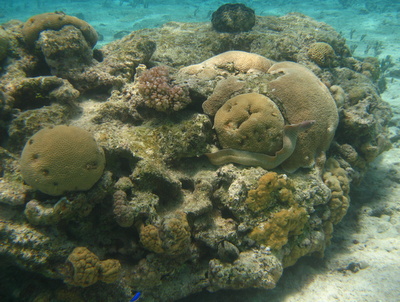 White-Eyed Moray Eel - not sure if we saw one of these before |
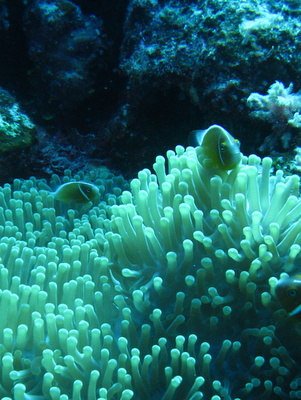 These Pink Anemone Fish were new to us too |
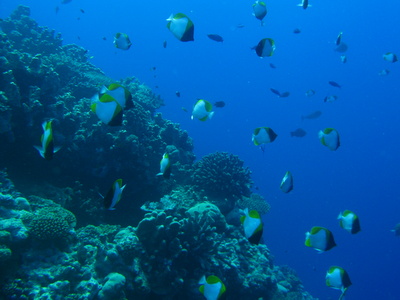 Lots of Pyramid Butterflyfish on the reef at North Minerva |
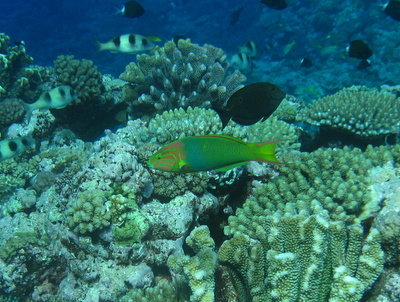 Pretty colors on a Sunset Wrasse |
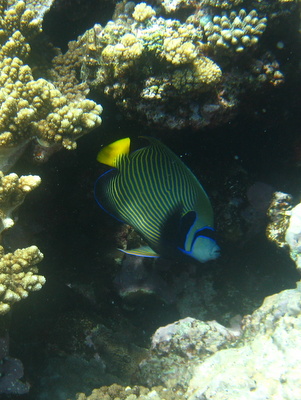 The biggest Emperor Angelfish we've ever seen |
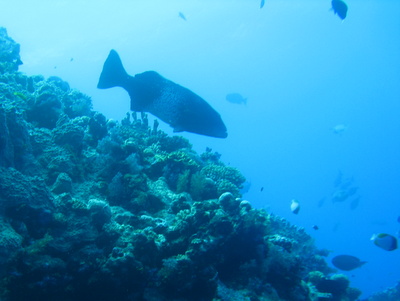 Giant Grouper swimming on the reef |
In addition to the diving, we enjoyed spending time with the crew of Jamie. We had met Tamás and Sara briefly in Raiatea in French Polynesia but we hadn't seen them since. They were avid fisherman and had caught a yellowfin tuna just as they arrived at Minerva, and they shared some fresh sashimi with us. Tamás and Sara are Hungarian and shared stories with us about what their life was like growing up in a Communist country - and they felt it was a good life. Tamás and Sara are a young couple, and were running charters on their boat (xta-sea.com). David was a guest who had chartered with them so often that he became a close friend. In addition to their charters, they served as a support boat for Jennifer Figge, a U.S. athlete who swam both the Atlantic and Pacific Oceans (jenniferfigge.com). The time we spent with these folks was fun, interesting and educational.
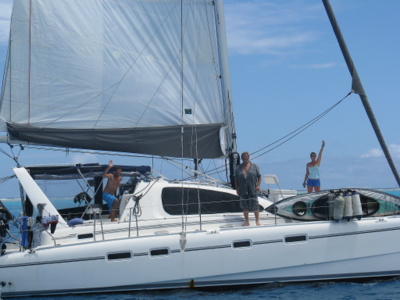 Waving good-bye to our dive buddies - Tamás, David & Sara on the catamaran Jamie |
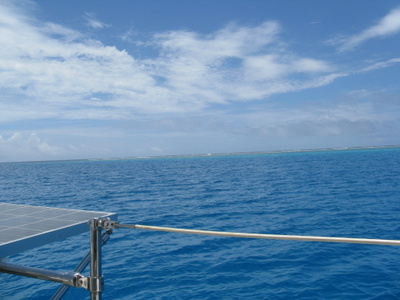 The view at Minerva Reef - no islands, just reef |
After a few days of diving, Jamie departed for New Zealand, and we moved Slip Away back to our original anchoring spot along the northeastern edge of the reef. It was a Friday afternoon, and we were anticipating hearing from Bob McDavitt, who was providing weather guidance to us for our passage to New Zealand. Earlier in the week, Bob had told us he thought we could depart any time over the weekend (maybe even on Monday) but that he would touch base with us on Friday to give us an update. We were hoping we could spend another couple days here to prepare for our passage to New Zealand (800 miles away) and maybe snorkel a couple more times. YOLO was still here with us, but everyone else had gone. We checked our email a couple of times on Friday and at 3 pm, we still hadn't heard from Bob, but we weren't concerned.
We checked our email again the next morning, and there was an email from Bob telling us the weather was right for our passage to New Zealand, and we should leave immediately. Dang! No time to loiter around, and we needed to hustle to get ready. No time for little, unimportant projects. Jan focused on preparing some food, and Rich cleaned the bottom of the boat. Dive gear was rinsed and stowed, everything else was in its place, and we were ready to leave by about 3 p.m. YOLO left about an hour before us. We were the last to depart, and since everyone else we knew was gone from this area, we "turned out the lights."
Passage from North Minerva Reef to Opua, New Zealand (December 10 to 16, 849 nm, 6 days + 5 hours). We were both apprehensive about this passage to New Zealand because one can reasonably expect to run into some rough weather somewhere along the way. Although most folks arrive safely, it's not always a fun ride. We heard reports of good passages from a couple of boats this year, but most ran into headwinds, occasional strong winds (40-50 knots) and rough seas. However, we needed to sail to a safe haven for hurricane season, and we wanted to visit New Zealand, so we were on our way.
We were pushing the hurricane season envelope slightly because it officially started on December 1 (and it was now the 10th), but early season hurricanes are pretty rare, and the general consensus among folks who have done this passage a few times is that one could usually expect a nicer passage in December than in November or October. In addition to hurricanes, another concern was a "weather bomb", which results from a rapidly deepening low pressure system. In 1994, a number of cruising sailboats were caught out in the "Queens Birthday Storm", which was a weather bomb event between New Zealand and Tonga. Weather bombs are pretty rare, but we didn't want to be anywhere near one of those!
Although it was highly unlikely that we would run into a hurricane or weather bomb, we could expect to deal with bad weather at some point in our voyage. Weather in this area is affected by systems that come out of the Tasman Sea, cross New Zealand and continue east. These systems usually pass through every five or six days, and we expected our passage to New Zealand to take about a week. Although we generally feel that we have enough weather information available to us to do our own forecasting, we were willing to pay for a little peace of mind for this passage and we enlisted the help of a professional. So, when Bob McDavitt said it was time to go, it was time to go!
In addition to Bob's input, we also closely studied an article written for the Seven Seas Cruising Association bulletin by John Martin on the sailing vessel Windflower. John claimed to have made the passage to and from New Zealand 38 times, so he had some good recommendations, which included (1) heading west and then south instead of taking a direct (southwest) course to New Zealand and (2) sailing through any trough or low pressure system north of latitude 30, where it will pack less punch. (Our destination of Opua, New Zealand, sits at 35 degrees south of the equator, so about 300 miles south of latitude 30.)
As it turned out, all our worrying was for naught - we had a great passage to New Zealand!
We left North Minerva Reef with
light winds and gentle seas, so we started out motoring. A couple hours
later, we had winds of 8 knots off the port beam, so we set our sails and turned
the engine off. We had a full moon that evening, but we didn't get to
enjoy it because it was a squally
night. The squalls weren't fun, but they
weren't too bad (nothing over 25-30 knots of wind). The next day the
clouds cleared, and for the next four days we had near perfect sailing conditions -
sunny days, moonlit nights, 10-20 knots of wind from the ENE, and reasonable
seas. We started out sailing in close proximity to YOLO, but our courses
diverged when we turned further south and YOLO continued on a more westerly
course. But then, we turned west and they turned south and shortly
thereafter, we were once again within a few miles of each other. Funny how that
happened! As we sailed further south, the air and ocean started to get
cooler, but the north winds kept it fairly warm. On the fifth day of our
voyage, we sailed through a weather trough, but we were expecting it, and we
were prepared - our sails were reefed, and we were only slightly south of
30 degrees south latitude. Although bad weather usually hits in the middle
of the night, our good passage karma was with us because the worst of the trough hit in
the middle of the day. We had 20-25 knot winds for a couple of hours and
strong squalls for about a half hour with a moderate amount of rain, but the
highest wind gust we saw was 35 knots. A boat further south had stronger
winds and their rough conditions lasted much longer than ours. After the
trough passed over us, the winds totally died, but the seas were rough and we
had an adverse current, so we turned on the engine, and motored for 23 hours.
During the high winds, YOLO sped out ahead of us, but when we had to
motor, we caught back up to them. With 56 miles to go, the winds built
from the west, and we once again turned off the engine. Those last 50
miles were the roughest, with 20-25 knots of wind from the west (on our starboard beam),
and 10 foot seas, but we were in the home stretch. By late that afternoon
we had land in sight. Almost there!! Since it was mid-December
(summertime in New Zealand),
days were long, so we could get in before dark. We cleared Cape Wiwiki by
about 6:30 pm, and with the land providing shelter from the seas, we took the
opportunity for a hot shower. At 7:30 pm, we doused our sails and turned
on the engine. At 8:30 p.m., just as the sun was setting, we pulled into
the Customs dock in Opua. YOLO was there to take our lines and help us tie
up - they arrived about an hour before us. We had eight cold beers left on
Slip
Away, and we shared them with our friends on YOLO. We were
feeling giddy as we celebrated not only a successful but a good passage
to New Zealand.
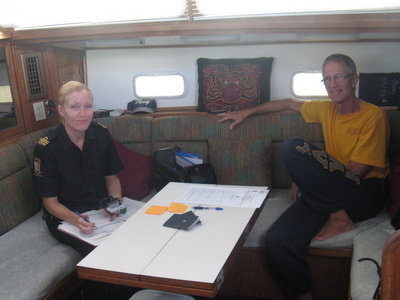 Checking in with New Zealand Customs the morning after our arrival |
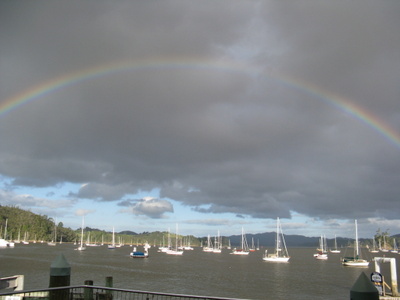 Rainbow over anchored boats at Opua Harbor |
